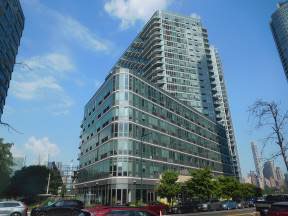NEW YORK CITY—Mayor Bill de Blasio has long claimed that creating and preserving affordable housing is his number one priority. But in Greenwich Village and the East Village, we have been consistently frustrated by his opposition to rezoning plans that would help create and preserve affordable housing where little exists, and his fierce defense of existing zoning which only results in construction of high-rise luxury condos, hotels, and boutique office buildings, in many cases by his campaign fundraisers.
Starting in early 2015, the Greenwich Village Society for Historic Preservation asked the mayor to rezone the University Place and Broadway corridors in our neighborhood. A flood of luxury condos, hotels and office buildings are being built in the area, and under the existing zoning, only more of the same will result.
A 300-foot-tall luxury condo tower is nearing completion on 12th Street, with no affordable housing, whereas under our rezoning plan, that development could have included 29,000 square feet or more of affordable housing. A slew of office towers catering to high-end firms are going up or being planned in the area at a similar scale, though most development in this part of the Village is no more than 12 or 13 stories (which is approximately what our rezoning plan would allow).
A significant part of what is driving this oversized development trend is the expansion of “Silicon Alley,” the home of the tech industry in New York City south from the Union Square/Flatiron area where it has thrived for years into this predominantly residential, low- to medium-rise area.
To address these trends, our rezoning would incentivize or mandate the inclusion of affordable housing in new developments, as has been done in other neighborhoods. It would not fundamentally change the allowable overall size of new development, but merely put in place reasonable height caps for new development similar to the heights of the tallest buildings currently in the neighborhood.
Along the 3rd and 4th Avenue corridors, we are seeking to close a loophole in the zoning for these blocks that allows developers to sidestep the existing affordable housing incentives by building purely commercial buildings.
That loophole recently resulted in the demolition of five modest walk-up apartment buildings with scores of permanent housing units, many of them rent-regulated, to make way for construction of a 300-room hotel by David Lichtenstein and his Lightstone Group. Lichtenstein has raised funds for the mayor and was appointed by him to the Economic Development Corp.
Our zoning plan would cut the size of commercial developments in this predominantly residential neighborhood, so new development would almost certainly be predominantly residential and subject to the affordable housing incentives. We would also be open to those incentives being made mandatory, as the mayor has claimed is his preference.
The mayor's response to these proposals? Adamant opposition. And not only is the mayor refusing to do anything about out-of-scale and out-of-character development in this area, he's actually proposing to make it worse.
The mayor has announced that in early 2018 he will seek to rezone a site abutting this area on 14th Street just off Fourth Avenue, currently occupied by a PC Richard store, to create an enormous “tech hub.” Lacking the zoning protections we are calling for, this will clearly increase the rate of high-rise condo and commercial development with no affordable housing in our adjacent residential area, accelerating the spread of “Silicon Alley”-related development in the vicinity. Ironically, the proposed tech hub site had been earmarked for affordable housing years ago.
If the mayor has his way, this part of the Village and East Village will retain zoning that will only lead to a vast flood of out-of-scale condos, hotels and upscale office towers, and miss opportunities to create or preserve affordable housing where it is sorely lacking.
Under our plan, supported by every local elected official and community group, new development would have strong incentives or requirements to include affordable housing, and would remain in scale with the neighborhood without unduly taking building rights away from the developers. It would allow these neighborhoods to continue to grow and change, as mixed use but predominantly residential neighborhoods, at a scale which makes sense and with affordable housing as part of the mix.
The lines are clearly drawn in this battle. Which side will the mayor be on? We'll find out in 2018.
Andrew Berman is the executive director at Greenwich Village Society for Historic Preservation. The views expressed here are the author's own.
Want to continue reading?
Become a Free ALM Digital Reader.
Once you are an ALM Digital Member, you’ll receive:
- Breaking commercial real estate news and analysis, on-site and via our newsletters and custom alerts
- Educational webcasts, white papers, and ebooks from industry thought leaders
- Critical coverage of the property casualty insurance and financial advisory markets on our other ALM sites, PropertyCasualty360 and ThinkAdvisor
Already have an account? Sign In Now
*May exclude premium content© 2024 ALM Global, LLC, All Rights Reserved. Request academic re-use from www.copyright.com. All other uses, submit a request to [email protected]. For more information visit Asset & Logo Licensing.










